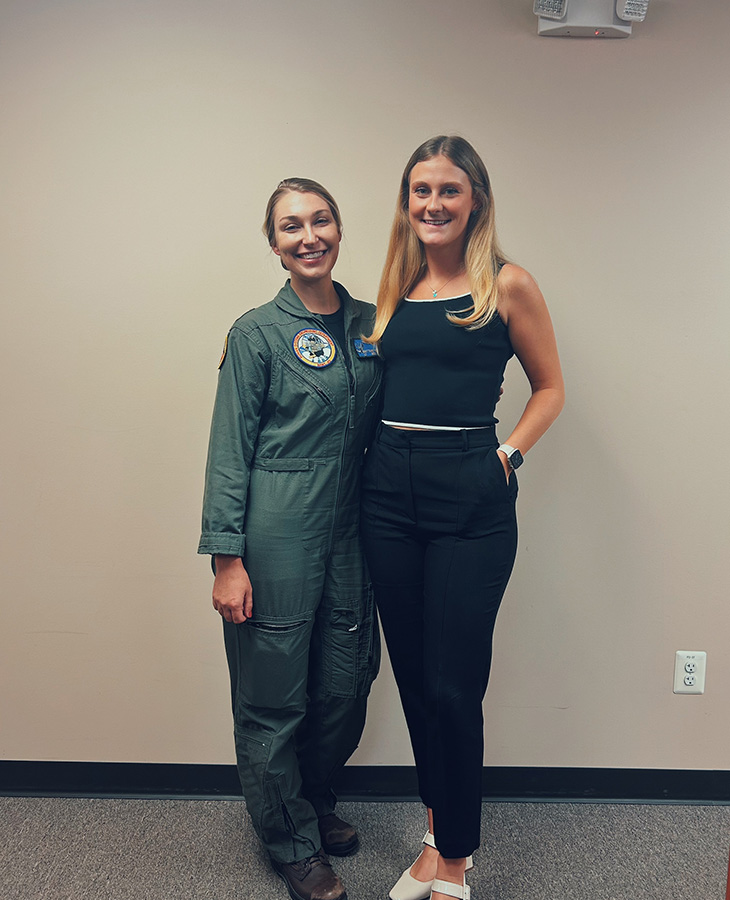
CEAT's Kyle pursuing third industrial engineering and management degree
Friday, September 13, 2024
Media Contact: Tanner Holubar | Communications Specialist | 405-744-2065 | tanner.holubar@okstate.edu
Ainsley Kyle is an industrial engineering and management major who just can’t get enough of the College of Engineering, Architecture and Technology at Oklahoma State University.
When she arrived as a CEAT undergraduate student, she hadn’t thought about obtaining three college degrees. Just a few years and a couple of degrees later, she is beginning her dissertation to obtain her Ph.D. in industrial engineering and management.
“I feel like I'm not done yet. I don't really know what I want to do, so I want a little bit more time and another degree to figure that out,” Kyle said.
At first, Kyle was a chemical engineering major, but she fell in love with industrial engineering and management after taking an IEM introductory course. She started researching with Dr. Katie Jurewicz her junior year, developing a passion for human factors research.
She enjoys the overall aspect of how industrial engineers focus on a particular problem. In some aspects, engineers isolate a problem and look to solve that specific issue. At the same time, industrial engineering and management approaches systems holistically and aims to understand how factors interact to form a problem.

“It's been great; I love it,” Kyle said. “I am obviously biased, but I feel like it is the most inclusive department on campus just because it is full of wildly diverse but like-minded people. I feel like our core engineers share a lot of similarities as problem solvers, as well as different perspectives and different skill sets.”
IEM is geared toward collaboration, and the inclusion of management gives Kyle the skills to help her manage projects and skills in a unique way. There is a lot of focus on probability and statistics, which she joked she was thinking of getting yet another degree in. She said taking various classes on key industry topics teaches her how to approach a problem as well as solve it.
“Industrial engineering teaches you those skills on how to approach tough problems,” Kyle said.
Kyle said even in a male-dominated field such as engineering, she has been able to gravitate toward many strong and intelligent women. She said it’s a pleasure to see their careers evolve through academia.
“It’s really great to have women I can talk to in this field,” Kyle said. “I always try to remember and thank them for their contributions because that’s hard work for a lot of people. My research adviser, Dr. Jurewicz, has been like my academic mother. She is my muse. She has been amazing and just the best advisor and mentor. I’ve been working with her since my junior year. I’d also say Dr. Jennifer Glenn; I took her freshman computer programming class. I eventually became one of her TAs for that class, and she’s just been a great role model.”
Finding her perfect internship
Kyle has been selective with her academic career.
She didn't start thinking about her master’s until completing her undergraduate degree. She didn't consider pursuing her Ph.D. until completing her master’s degree. She also took her time when choosing an internship.
Kyle said because she has specialized in human factors research, she wanted to find an internship that would definitively help her in her career, somewhat holding out. She studied abroad in Italy between her junior and senior years and attended a research trip to France for a conference with Jurewicz.
“I feel I’m a testament to not compare your path with anyone else’s,” Kyle said.
While presenting her research at a conference for the Human Factors and Ergonomics Society in Washington, D.C., in October 2023, Kyle learned of the Naval Research Enterprise Internship Program. She was accepted and spent the summer at the Naval Air Warfare Center Aircraft Division Patuxent River in St. Mary’s County, Maryland.
She helped on the first Navy initiative by studying brain-computer interfaces for fighter jets. She said the research is similar to what she has learned with physiological measurements while studying human factors at OSU.

While with the Navy, she helped measure brain activity using an electroencephalogram, as well as heart rate variability, breathing entropy and gaze tracking. These research areas are geared toward the physical limitations of pilots, as well as identifying and extending those limitations for the betterment of the pilots.
“It feeds back to industrial engineering, and human factors specifically, where we want to design a system that can fit a variety of people and their skill sets to kind of be adaptable," Kyle said. "I’m also very interested in finding non-intrusive measurements of cognitive workload in these complex and dynamic environments.”
Now that Kyle has been introduced to the defense industry, she would like to pursue an internship with the Air Force. She highly recommends defense internships like NREIP, as 10 weeks is a good amount of time to get a glimpse of what the work will look like.
She is a proponent of becoming involved in research opportunities as much as possible. Kyle jumped at the chance to work for OSU, which led her to discover research opportunities and build relationships with faculty and her peers.
“If you had told me in my junior year, when I had just started doing basic human-computer interaction research, that I would be doing a flight simulator study with a mechanical aerospace graduate student, I would not have believed it,” Kyle said. “It’s like a decision tree where each decision leads you to the next decision.
"But if you don’t ask those questions and take the initiative, you’ll never know what’s out there.”
